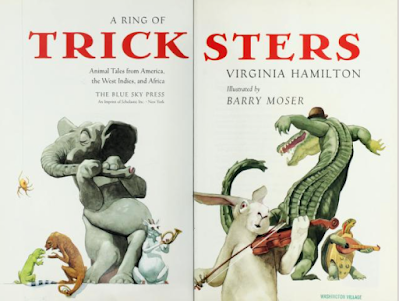Like Bryan and Lester, Virginia Hamilton worked with both African and African American storytelling traditions, and the book I want to feature today includes stories from the United States, the Caribbean, and Africa: A Ring of Tricksters: Animal Tales from America, the West Indies, and Africa. And yes, this beautiful book, with illustrations by Barry Moser, is available for digital lending at the Internet Archive; it's just a click away.
The book contains four stories from African American storytellers (two rabbit trickster tales, plus a fox and a wren trickster too), three from Caribbean storytellers (all Anansi stories), and four from African storytellers. I will focus on the African stories in this post, and I'll return to this book again later when I start profiling African American and Caribbean books at the Internet Archive... but that will be a while since there are lots (LOTS) of African folklore books I want to profile first.
The four African stories that Hamilton includes come from Sierra Leone (three stories) and Mozambique (one story). Although Hamilton provides notes on the stories, she does not provide information about her actual sources, although my guess is that the three Sierra Leone stories come from the stories Florence Cronise collected in Sierra Leone and published in 1903 (Cunnie Rabbit, Mr. Spider, and the Other Beef: West African Folk Tales), and that the Ndau story from Mozambique comes from the stories told by Columbus Kamba Simango and published by Natalie Curtis Burlin in 1920 (Songs and Tales from the Dark Continent). Since both of those books are available at Internet Archive also, I'll say something about them in future posts.
One of the fascinating features of the Sierra Leone storytelling tradition is the character of the trickster "Cunnie Rabbit," who is actually not a rabbit but instead a water chevrotain, also called a fanged deer, which is a tiny, elusive creature; you can find out more at Wikipedia. The chevrotain is also the main trickster character in Malaysian folktales! Here's a picture of a chevrotain (photo by Dave Curtis):
And here's one of Barry Moser's illustrations for a "Cunnie Rabbit" story in Hamilton's book:
And here's an illustration of "Cunnie Rabbit" by Gerald Sichel in Cronise's book:
The way that Hamilton tells the African stories is marvelous, using many of the pidgin features of the Sierra Leone stories, but making them easier to follow than the versions in Cronise's book (I'll do some comparisons when I write up a post about that book). Here's Cunnie Rabbit digging for water during a drought:
By and by, Cunnie Rabbit, him, runs home. There, he start'um dig down. He did and dig down. For what? Him rabbit is digging for a well, what for! Water comes soon, and he drinks he-self cool, way down inside him.
Likewise, in the Ndau story, Hamilton uses all the Ndau names for the animals: Shulo the hare, Hamba the tortoise, and so on, and she also includes some of the singing (I'll say some more about that when I do a post on Simango's stories).
So, in short, wonderful stories await you... you can jump into the "ring of tricksters" anywhere and see what you find! The tricksters are all just one click away:
A Ring of Tricksters:
Animal Tales from America, the West Indies, and Africa
by Virginia Hamilton
(see the animal blowing his horn underneath Elephant?
that's Cunnie Rabbit!)





No comments:
Post a Comment
Comments are limited to Google accounts. You can also email me at laurakgibbs@gmail.com or find me at Twitter, @OnlineCrsLady.